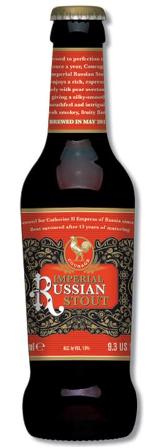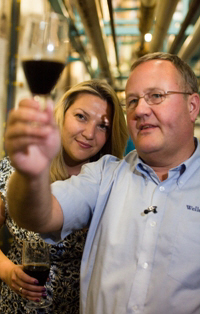Top Tastings 2011
ABV: 10%
Origin: Bedford, Bedfordshire, England
Website: www.wellsandyoungs.co.uk

Wells & Young's Courage Imperial Russian Stout 2011
Excitement rippled through the beer world in Autumn 2011 as one of Britain’s most historic beer brands made an unexpected return from the dead. Courage Imperial Russian Stout can trace its lineage back to the Anchor brewery on the original site of William Shakespeare’s Globe theatre on Bankside, Southwark, which in 1781 became Barclay Perkins – a means to become “rich beyond the dreams of avarice” as Samuel Johnson commented when he handled the sale as the executor of deceased former owner Henry Thrale. The new owners lived up to Johnson’s word – the brewery became the world’s biggest, a major producer of the dark, vinous porter beers for which London was famed as the first capital of industrial brewing.
The beers now known as stouts evolved from strong porters which were labelled ‘stout’ in the sense of ‘strong’. Barclay Perkins led the field in exporting particularly stout bottled porters of 10% ABV or more to the Baltic nations, including to Russia which from 1703 had become more accessible with the creation of the port city of Sankt-Peterburg. These stouts even gained a following in the opulent royal palaces that brightened this massive country’s “window on the West” and were apparently appreciated by Empress and Autocrat of all the Russias Catherine the Great herself, acquiring the adjective ‘imperial’ not, as is still sometimes supposed, in honour of the British Empire but of the Russian one.
By the end of the 19th century prohibitive import duties had put an end to the Russian trade but the Anchor brewery continued brewing its imperial stout through the merger of Barclay Perkins with the nearby Courage brewery in 1955. Production was now limited to an annual brew packed in vintage dated bottles, now bearing the new owner’s brand, though the traditional technique of refermentation in the bottle was retained throughout the beer’s history – it was one of only five known British bottle conditioned beers still in production when the Campaign for Real Ale was founded in 1971, and one of the few beers then noted for its ageing potential.
By the 1970s Courage had relocated the brewing of Imperial Stout to its own facilities at Horsleydown at the south end of Tower Bridge, though continued to mature and bottle the beer at Barclay Perkins until the latter site finally closed in 1981. Production was relocated in 1983 a long way from its original home, at John Smith’s Magnet brewery in Tadcaster, North Yorkshire, where the end of the line was finally reached in 1993, the last year of regular production under the auspices of Courage.
Aside from a couple of minor glimmerings – some pasteurised bottles that briefly appeared on the Scandinavian market later in the 1990s, a one-off cask version at the 2003 Great British Beer Festival – the venerable line of brewing heritage appeared extinguished. Meanwhile other breweries moved into the gap on the shelves, notably Harveys, who recreated the stout imported into Russia from Britain in the 1820s by the A Le Coq company, itself perhaps derived from a Barclay Perkins recipe.

Wells and Young's head brewer Jim Robertson (foreground) admires the revived Courage Imperial Russian Stout with beer writer Melissa Cole, who helped recreate the beer. Pic: Wells & Young's
Now, almost two decades after the last regular brew, Courage Imperial Russian Stout has reappeared thanks to Wells & Young’s. The enterprising new national struck a deal in 2007 to take over the production and marketing of the Courage brands from their then owner, Heineken, beginning with the standard and special bitters Courage Best and Director’s. In 2011 W&Y gained complete control of the brands and celebrated in splendid fashion in May with a new bottling of the historic strong stout, packaged in half pint bottles with red labels that pleasingly recycle elements of the iconic 1970s design.
Of course Young’s, one half of the original 2006 merger that created Courage’s new custodians, was once itself a London porter brewer, though much smaller than Barclay Perkins, and if Imperial Russian had ended up at Young’s historic Wandsworth site it would almost have been like coming home. Sadly that site now lays derelict and the 2011 version was produced at W&Y’s Bedford plant. But there’s a pleasing personal connection, as head brewer Jim Robertson is a former Courage employee who was involved in brewing the stout at Horsleydown in the early 1980s.
It was also noteworthy that W&Y chose to launch the new brew not in London, nor even in the UK, but at September’s Great American Beer Festival in Denver, Colorado, an indication of how the principal market for beers like this has shifted quite a long way west of the Baltic. Very little 2011 Imperial Stout found its way to British customers, and even beer writers and industry figures had to wait till December to get their tasting samples. Next year’s brew is expected to be more widely distributed.
Jim set out to recreate the stout he remembered from the 1980s, with pale, amber and black barley malts and lots of Styrian Goldings hops. Once again the beer is bottle conditioned. Although my sample was tasted relatively young at just over six months, it was already a mightily impressive and indulgent brew.
The beer poured near black, with a thick and creamy beige head. A sweet, caramelly aroma had notes of coffee, rum and raisin, a theme that continued in the rich and thick but sparkling palate, with fine chocolate and developing fruity raisin notes, a treacly sweetness and some biscuity malt. The finish was both drying and warming, with tannic notes and powdery bitter chocolate, swirled with complex esters that revealed late pear-like flavours.
The ageing potential is obvious, and I’m grateful to Wells and Young’s for sending me two bottles so I could stash one away to see what became of it. I also couldn’t resist cracking open one of my few precious remaining bottles of the 1993 John Smith version for comparison. It’ll be difficult to wait 18 years to taste the 2011 again.





I too found the beer quite young and decided not to write about it as I expect I wouldn’t be able to conceal my disappointment. I’ll wait a few years and see how the other bottle tastes!
What I’d like to know is which recipe W & Y used for the new version. There have been a number of variations over the years/decades/centuries and it would be nice to know whether we now have a new interpretation or a deliberate attempt to recreate one of the earlier incarnations and, if so, which. From what you say, I guess you don’t have answer to that one Des? Anyone else know? Unfortunately an email I sent to the brewery on this issue has gone unanswered.
Thanks for comments both. The video on the W&Y website reveals something about the recipe, and I’ve now amended my writeup above to match. Seems to me the key ingredients in the grist — amber and chocolate malt — are the same as they were in the early 1990s. The hop is Styrian Goldings, which, as a variety derived from Fuggles, has a character not far from British 19th century hops. In the video Jim Robertson gave the impression he was aiming to recreate the beer he remembered brewing at Horsleydown in the early 1980s rather than going back to historic recipes. I’m trying to find out more.
[…] has been rammed full of English hops (Fuggles was my guess, though I see from Des de Moor’s tasting notes that they were actually Styrian Goldings, which are, of course, despite their name, […]
where can we buy this beer in St albans herts?
I just found these on sale in Tesco, 4 for £6.
Think they may have priced them wrong, so I took the lot!
Like JohnBoy, found a stash at Tesco and cleaned them out!!
I’ve tried the latest stuff and really enjoyed it but I’ve been offered 2 bottles of Imperial Russian Stout from 1975 & 1976. Does anyone know if these are worth having and what their likely value is?